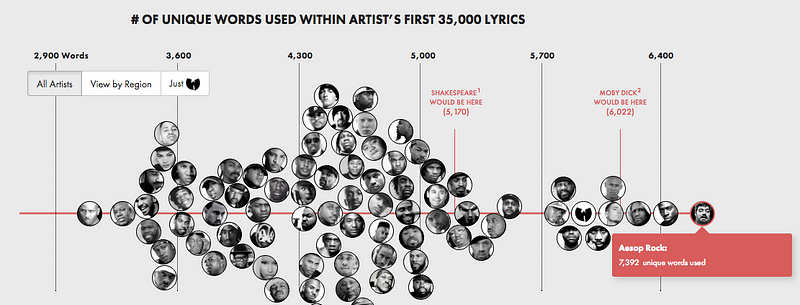Not too long ago I had an experience that made me look differently on the way I use words. We were holding a workshop with colleagues from Korea and USA. Everything we’ve planned went well and the responses were good. Then we took them for dinner and drinks. A number of beers later, the lead Ux designer of the American team disclosed to me that he thinks I’m using altitudinous words in my presentations. He mentioned that at times they were dazed by the vocabulary. The others agreed and said that they had to go to the dictionary to figure out the exact meaning of a word. We laughed about it. They said I do UX poetry.
It was a good time to start explaining to my colleagues: “I have a confession, in my past, I used to be a rapper”. Everyone’s like “wow”…to counter all of the trillion preconceptions that just bounced into their head I ask “do you know Aesop Rock?…no…how about Sage Francis, Buck 65…maybe Talib Kweli / Mos Def?” then usually I get one “yes”. That was the kind of hip hop I tried to do.

The point is: I’m in love with language, structure, words, rhymes and their meanings. When I was a child I spent hours going through rhyme books, dictionaries, philosophers. I love reading Zizek and going through the same sentence 8 times and maybe get it, or listen to Ghostface Killah and work my way through the slang. I love reading poetry and I also love wowing people with pompous words.
These rappers are less popular. Who reads philosophy nowadays? What does it have to do with UX?
Defining things in UX is crucial. Since the UX discussion is focused on users’ emotions it is eminent to describe it to the best of our ability. Vocabulary shouldn’t be compromised in presentations. The meaning of better communication is to say exactly what you meant and then if needed support it with simpler words.
There must be a parity between an eloquent text and the speaker’s elocution.
Importance of words
It’s never simple to simplify and to find the essence of a “thing”. It’s harder to constrain an emotion into a sentence. When dealing with UX we analyze human behavior and try to use pre-made experiment assumptions and methods to observe and extract meaningful insights. Being able to analyze behaviors require patience and the ability to just facilitate and empathize. Documenting it entails removing preconceptions, ego, and judgmental obstructions. Analyzing it make assumptions rise again through natural comparisons of people for example.
Everything ends up in text or visual format
The process involves dozens of tasks with each of them ending in a written output. The way they will be written and presented will dictate how serious the output will be treated and how will it be absorbed by the rest of team. When it’s all done, written and shared, the creator has to live with it for a while, it’ll turn into a creation condition. These words become the mainstay in which the design ship will be built upon. The definition of the user and the problems will find themselves to the people who are less involved directly. It will be a seed that stays in their head and will grow the business unrestrainedly and unsupervised.
Users are not always right and therefore testing is just the beginning of the process. On top of that experience, a solution is being developed. Every report needs to end with “next steps”. Paragraphs that describe potential solutions should inspire using a vision, maintain simplicity and reveal the road to the target.
Controlling the means of expression means better control of the process.
When reading poetry people’s feelings diverge. I try to create a scenario where everyone has the luxury to think different but eventually it feels the same.
Importance of keywords
Behind every simplicity, there is hidden complexity and the same applies to keywords. Each of them is the key to a passage of information. Eventually, they all end up in the same space, interacting with each other and creating the experience.
Keywords are pillars for the memory of the listeners and if the storytelling and weaving process is done, strong connections can be formed around your designs. A design is not only making per say, it is also communicating. We communicate it to people we present to, people who will read it later, people who don’t have time and will just skim through the pages. When we communicate there are infinite cases to cater and think of.
Be a diplomat when you co-work. Be a poet, strife and ferocious when reaching the conclusion.
UX poetry is your chance to make a difference in a more personal way. Don’t get things diffuse by misunderstandings; write and design the future by any mean of expression, and make it eloquent.

